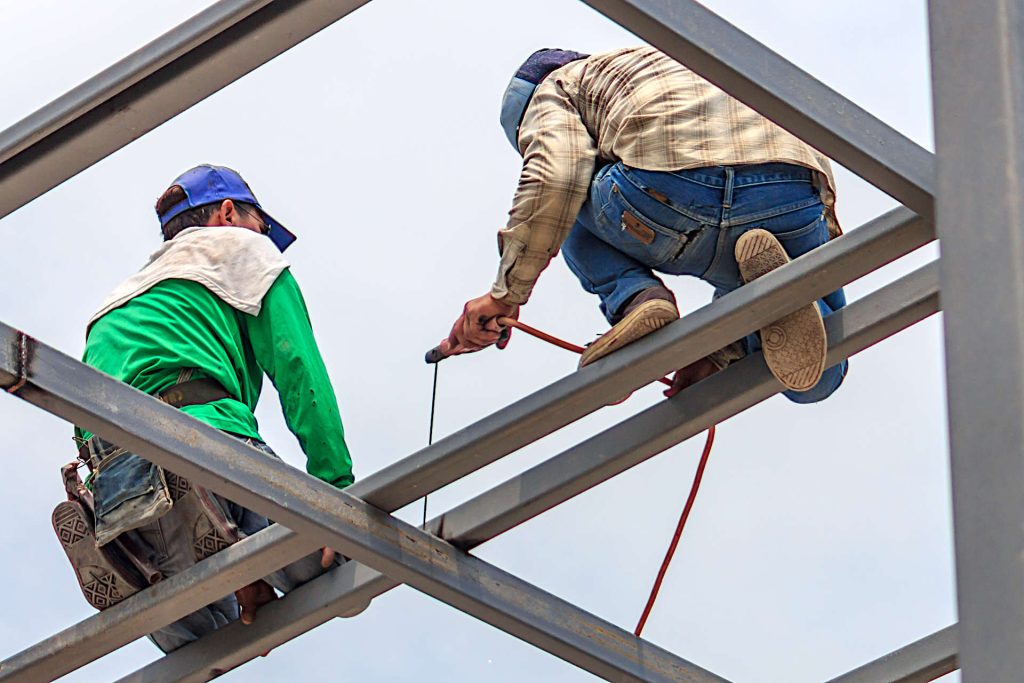Stick Welding: Welding without Gas using SMAW
Stick welding or Shielded Metal Arc Welding (SMAW) to give its proper name is a welding method that doesn’t require a shielding gas. Welding without gas using SMAW is a technique that involves using a flux-coated electrode to shield the weld pool from atmospheric gases, instead of using an external shielding gas.
This technique is commonly used in outdoor or windy environments where it is difficult to maintain a stable gas shield. Welding without gas is also preferred in situations where using an external shielding gas is not practical or cost-effective.
Understanding Shielded Metal Arc Welding (SMAW)

Shielded Metal Arc Welding (SMAW) is one of the most popular welding processes used in the industry. It is also known as stick welding, manual metal arc welding (MMAW), or flux shielded arc welding. It is a welding process that uses a consumable electrode, which is coated with flux to shield the welding area from atmospheric gases.
How does the flux coating on an electrode when stick welding shield the weld against contamination
When an electric current is passed through the electrode in stick welding, it melts the metal and the flux coating. The flux coating vaporizes and creates a protective gas shield around the weld, preventing atmospheric contamination and helping to create a stronger weld..
As the arc heats the electrode, some of the flux coating also disintegrates, releasing protective gases, mainly CO2, that help to shield the weld from atmospheric contamination. This stabilizes the electrical arc at the tip of the electrode. The flux also produces slag, a layer of solid material that covers and protects the weld from oxidation and other contaminants while it cools down.
Different types of consumable electrodes coated in flux and their uses in SMAW welding
The flux coating on the electrode used in SMAW plays a critical role in welding without gas. The flux coating melts during welding and produces a gas that covers the molten weld pool to prevent atmospheric gases from contaminating the weld. In addition, the flux coating also produces slag, which protects the weld from oxidation and helps to produce a clean and smooth weld.
There are several types of consumable electrodes coated in flux that are used in SMAW welding. Each type of electrode has its unique characteristics, and the type of electrode used will depend on the metal being welded, the welding position, and the thickness of the metal. The following are some of the most common types of consumable electrodes used in SMAW welding:
- Cellulose-coated electrodes: Cellulose-coated electrodes are commonly used in welding pipelines, and they are ideal for welding in out-of-position positions. The cellulose coating on the electrode produces a significant amount of hydrogen gas, which helps to penetrate deep into the weld joint.
- Rutile-coated electrodes: Rutile-coated electrodes are the most commonly used electrodes in SMAW welding. They are easy to use and produce a stable arc with low spatter. Rutile-coated electrodes are ideal for welding mild steel and low alloy steel.
- Basic-coated electrodes: Basic-coated electrodes produce a significant amount of slag, which helps to protect the weld from oxidation. They are ideal for welding low-alloy steels and are commonly used in the construction industry.
- Iron oxide-coated electrodes: Iron oxide-coated electrodes are ideal for welding stainless steel and other corrosion-resistant metals. They produce a stable arc and low spatter, which helps to produce a clean and smooth weld.
When selecting the appropriate electrode for SMAW welding, it is essential to consider the type of metal being welded, the thickness of the metal, and the welding position. Welders must also ensure that the electrode they choose is compatible with the welding machine and the welding environment.
Challenges and precautions for welding without gas using SMAW
Welding without gas using SMAW presents some challenges and requires special precautions. The welder must ensure that the flux coating on the electrode is appropriate for the metal being welded. The welder must also be careful to use the correct welding technique to prevent the weld from becoming contaminated with slag or other impurities. In addition, the welder must pay attention to the environmental conditions, such as wind or rain, which can affect the quality of the weld.
Benefits of welding without gas using SMAW
One of the main benefits of welding without gas using SMAW is that it eliminates the need for an external shielding gas, which can be expensive and difficult to use in some environments. This technique is also more portable than other welding processes, which makes it an ideal choice for fieldwork. Welding without gas using SMAW can also produce high-quality welds, provided that the correct technique is used.
Procedure
To use SMAW for welding without gas, the following steps should be taken:
- Prepare the workpiece by cleaning it thoroughly to remove any dirt, rust, or other contaminants.
- Select the appropriate electrode for the metal being welded. The electrode should be chosen based on the type of metal, thickness of the metal, and the welding position.
- Set up the welding machine and connect the electrode holder to the positive terminal of the machine.
- Put on the welding helmet and gloves and strike the arc by tapping the electrode against the workpiece.
- Maintain the correct arc length and welding speed and move the electrode in a straight line along the joint to create a strong and durable weld.
- Once the weld is complete, use a chipping hammer to remove the slag from the weld joint.
Wrapping Up
Stick welding is one of a number of methods of welding without gas. The other principle method used is flux- Cored Arc Welding and this can include MIG flux-cored welding. Finally you can also use TIG flux-cored welding but this is a more difficult process to master.
Welding without Gas using SMAW
SMAW welding is a versatile technique that can be used to weld a wide range of metals without the need for an external shielding gas.
The flux coating on the electrode plays a critical role in welding without gas, and there are several types of consumable electrodes coated in flux that are used in SMAW welding.
By understanding the characteristics of each type of electrode and selecting the appropriate electrode for the job, welders can produce high-quality welds that meet the required standards.
Further Reading
- RSI: What Is Stick Welding (SMAW) And Why Does It Matter?
- Universal Technical Institute: What Is Shielded Metal Arc Welding (SMAW)? The Beginner’s Guide

I’ve been involved in the welding industry for over twenty years. I trained in various engineering shops working on various projects from small fabrication and repairs through to industrial projects.I specialize in welding aluminum and food grade stainless steel and an now run an engineering shop fabricating equipment for the food industry.